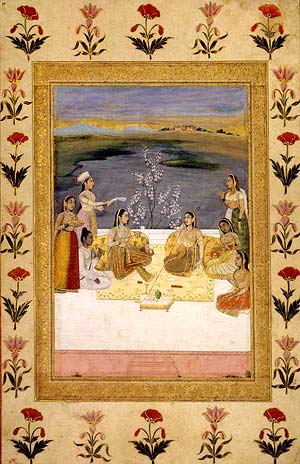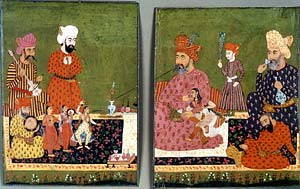| The Realm of Kings | The Hunt | Court Life | Kings, Courtiers, and Women | Courtly Manuscripts | The Realm of Gods | |||||||||

Rai Dalchand
Two ladies on a terrace Mughal; ca. 1700–05 Opaque watercolor and gold on paper Cynthia Hazen Polsky Collection (1008-IP)

A nobleman and courtiers entertained by musicians
Sind, Western India; 1750–75 Opaque watercolor and gold on paper Cynthia Hazen Polsky Collection (1060-IP) |
Kings, Courtiers, and Women Until the sixteenth century, there are few realistic representations of Indian rulers or courtiers. However, the early Mughals showed a new and restless inquisitiveness about man and nature, focusing their attention on the individual, the particular, and the idiosyncratic. Akbar (r. 1556–1605) enthusiastically nurtured the naturalistic techniques that his artists were adapting from European prints and paintings. Soon, the finely finished individual portrait became valued in its own right. Accomplished individual or small group portraits of the ruler, princes, nobility, and courtiers, as well as paintings of women or other subjects of interest, would be mounted in lavishly decorated borders and assembled in bound albums for the enjoyment of the emperor and his family, and to give away as gifts. Following the Mughal example, Rajput rulers also commissioned portraits of themselves, but these often referred to older notions of idealized rulers and paid less attention to observable, individualized traits. In the nineteenth century, fine portraiture continued to be produced, often under increasing Western influence. Sometimes the subjects were the newly ascendant British governors, or nabobs. By the middle of the century, however, the art of portraiture was in general decline, and it was replaced soon after, except at the most conservative courts, by photography. |